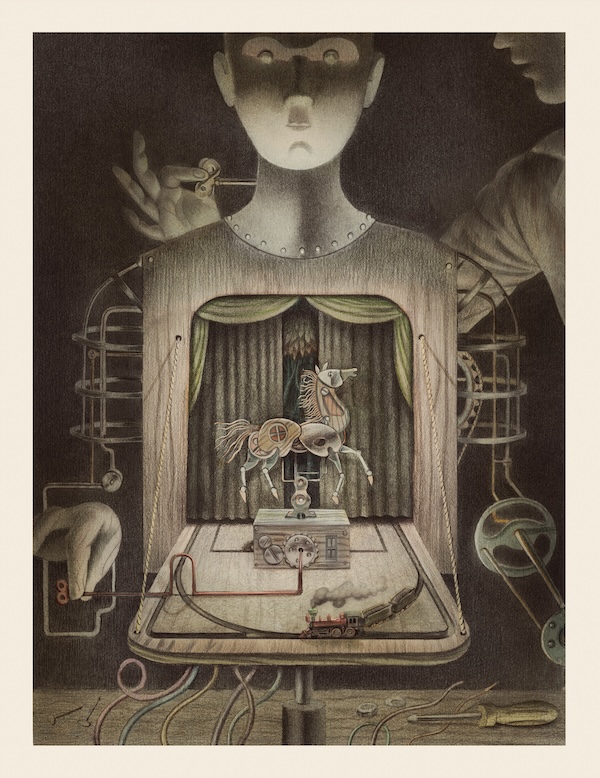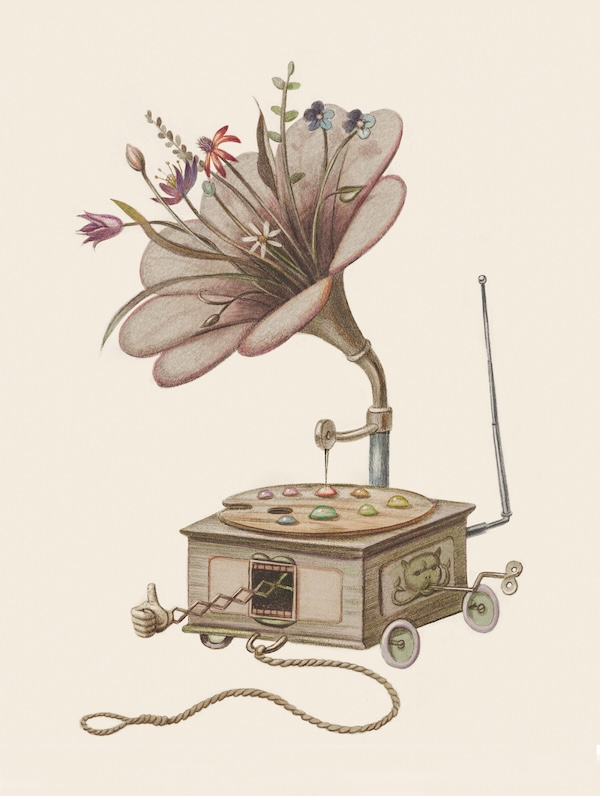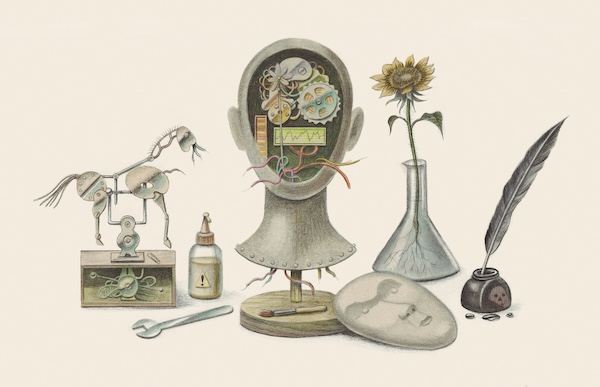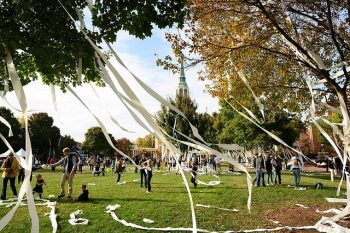
I have had the good fortune not only to make a career with books — as a bookseller, publisher, author and director of a literary arts nonprofit — but to get to stay in North Carolina to do it.
In that career I’ve known and worked with enough creative people that I can say this with confidence: There’s
no such thing as “creative people.”
There’s only people.
Everyone creates, at least a little bit. They make up stories or jokes, or add new twists to old ones; they whip up recipes, or add spices to old ones; they come up with technologies or processes never tried before, or improvements to those that already exist. Everyone really does have a book in them, after all.
That doesn’t mean their book is any good. That doesn’t mean their ideas are at all feasible or practical or beneficial. That doesn’t mean that their recipes won’t taste like boiled shoes, or that their jokes would make anyone laugh, or that their stories keep anyone’s attention. That doesn’t mean they’ll have the opportunities and the resilience and the weird alchemy of arrogance and insecurity to turn their creativity into business plans, their recipes into restaurants, their stories into books or movies.
They created something, though, something that existed in the world even if no one else knew about it. Everyone creates: Or, to be more precise (professors will read this, after all), no one “creates.” We combine; we join the elements at hand in ways they haven’t been before, or in a long time, or in quite the same way. We “increase the variety of the created world rather than reduce it,” the propensity to which is how author and critic Clive James defined the creative impulse.
“Everyone creates, at least a little bit. They make up stories or jokes, or add new twists to old ones; they whip up recipes, or add spices to old ones; …”
I can say this with confidence, too: Creativity is not, in and of itself, a moral good. Someone created OxyContin and its marketing plan. Someone had the bright idea to blow the tops off mountains to get to the coal. Someone created subprime mortgages. Someone created cable news and social media, and no matter how much I enjoy the information and connection, I’m not convinced those are net gains to anyone but their shareholders. “Creativity” is not inherently Pro Humanitate.
Neither, for that matter, is a Wake Forest degree.
We hate to admit it, but of all the Demon Deacons who have made contributions in creative fields, all the poets and journalists and scholars nurtured by Mother, So Dear, none have had as much popular success or cultural impact as Thomas Dixon Jr. (1883). Dixon wrote a trilogy of novels and adapted two into a stage play that toured the country to sold-out crowds, despite being banned in several cities. The play became the basis for director D. W. Griffith’s “The Birth of a Nation,” the film that revolutionized the movie business, turning lowbrow entertainment into an art form.
Dixon’s novels and play also were clumsy, witless, racist pastiches that refined and popularized the South’s noxious “Lost Cause” mythology. They introduced the idea of cross burning, and the play’s performances led directly to at least one lynching. Dixon’s old friend from Johns Hopkins University, President Woodrow Wilson, screened “The Birth of a Nation” at the White House, after segregating federal civil service departments that had been integrated — and working just fine — for decades. “The Birth of a Nation” helped revive the Ku Klux Klan, killing thousands, terrorizing millions.

I’m willing to bet Dixon would have said — with a straight face and pure heart, without qualm or hesitation — that he wrote every word pro humanitate, but his words, his creativity, damaged the nation in ways we have yet to repair.
We may never finish those repairs. That, too, is something those of us from “Work Forest,” overachievers and planners that we tend to be, hate to admit: We might never reach the goal, cross the finish line, win the prize. We might have to settle for the work itself, the act of creation, the small and incomplete contribution to the “created world.”
Robert Gipe (’85) added his own pen-and-ink drawings to the words of “Trampoline,” “Weedeater” and “Pop,” his “illustrated novels,” a format that sometimes softens and sometimes sharpens but always deepens the reader’s experience of his stories of life in the coal country of eastern Kentucky.
Gipe has spent most of his adult life there, since graduating summa cum laude from Wake Forest. Those mountains have fed not only his novels but the 10 plays he has helped produce through Higher Ground, the community performance project he founded in 2003.
“We write plays and put them on. We draw from oral histories we collect. We hire all kinds of professional theater artists to help us look our best,” Gipe says. “All kinds of people get involved. We’ve had coal miners and outlaws and lawyers and students and whole families. Significant LGBTQ+ participation, African American participation. People of all ages. Income brackets. What they get out of it varies, as you might imagine. We try and keep it fun, but deal with issues of import to the community. It is a pretty good artistic outlet for people who don’t have the luxury to pursue the arts as a career.”
Gipe says, “I like creating stuff that leans towards art with people who don’t consider themselves artists. Telling stories and making music are nice entry points.”
Dhonielle Clayton (’05) took elements of mythology, the history and culture of New Orleans and its Creole community, and the contemporary commodification of beauty, and spun them into the novel “The Belles” and its two sequels.
Finding that she had more story ideas than one person could write — and that too many writers from marginalized communities had stories they could not get published — she founded Cake Creative and its “edgier sibling” Electric Postcard Entertainment, which develop inclusive and appealing stories and then package that intellectual property across media, from publishing to film or TV producers, seeking to “ensure the next generation of readers can find themselves on the shelves and in story,” according to Cake’s website.
In 2023, The New York Times called Clayton “a former librarian whose hyperactive imagination has spawned a prolific factory for intellectual property. Though her name doesn’t always appear on the covers of the books she conceives, she has quietly become an influential power broker in the book world.”
She also serves on the board of directors of We Need Diverse Books, a nonprofit “that advocates essential changes in the publishing industry to produce and promote literature that reflects and honors the lives of all young people.”

Like dandelions, it will take seed and root though covered by concrete (or algorithms) and bloom through the smallest sliver of a crack. Like dandelions, even the humblest, clumsiest act of creativity offers delight if we want it, nourishment if we need it, …”
Megan Mayhew Bergman (’02) has used fiction, creative nonfiction and journalism to face the climate crisis. The author of a novel and two collections of short stories, she also has written articles and essays for The New Yorker, The Atlantic, Harper’s Bazaar and other publications, including The Guardian’s recurring column “Climate Changed,” describing for a global audience the effects of the climate crisis on the American South.
In addition to writing, she founded the nonprofit Open Field “to engage with the general public on outdoor storytelling, predominantly as it relates to climate.” Open Field offers workshops and resources to help people tell their stories of climate change in ways that will resonate with people who don’t consider themselves environmentalists.
“I think the environmental sphere has traditionally looked and sounded a different way,” she says, “and created elitist and self-righteous energy that makes it difficult for the general public to feel a sense of belonging in climate conversations. I believe everyone has a story to tell about their connection to place, and about the ways environmental degradation affects them. I want to open up these conversations so that more people feel a part of the environmental movement and conversations.”
She also runs a consulting firm called GreenStory with a partner that helps environmental NGOs and clean-tech firms “better tell the story of what they do.”
“It’s honestly brought me a lot of hope,” she says, “digging into the good work in the world.”
I can say this with confidence, last of all: Nobody can kill creativity-as-process, no matter how hard they try. Like dandelions, it will take seed and root though covered by concrete (or algorithms) and bloom through the smallest sliver of a crack. Like dandelions, even the humblest, clumsiest act of creativity offers delight if we want it, nourishment if we need it, if nothing finer and more sustaining can be found.
But should it have to?
“I think making things, creating something new, reminds us that we do have some agency in this life,” Gipe says. “It reminds us that most everything around us was made, and thus could be remade. And if you kind of live by that, it gives you some hope that things could be better. Creativity and hope are, if not the same thing, at least cousins.”
Ed Southern is the editor of the new anthology, “The Devil’s Done Come Back: New Ghost Tales from North Carolina,” and the author of the book “Fight Songs: A Story of Love and Sports in a Complicated South.” His work has appeared in The Bitter Southerner, StorySouth, the North Carolina Literary Review and elsewhere. Since 2008, he has been the executive director of the North Carolina Writers’ Network.


